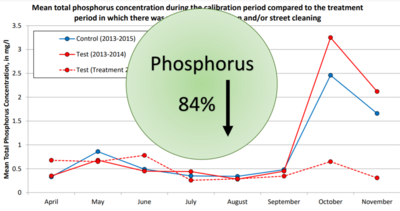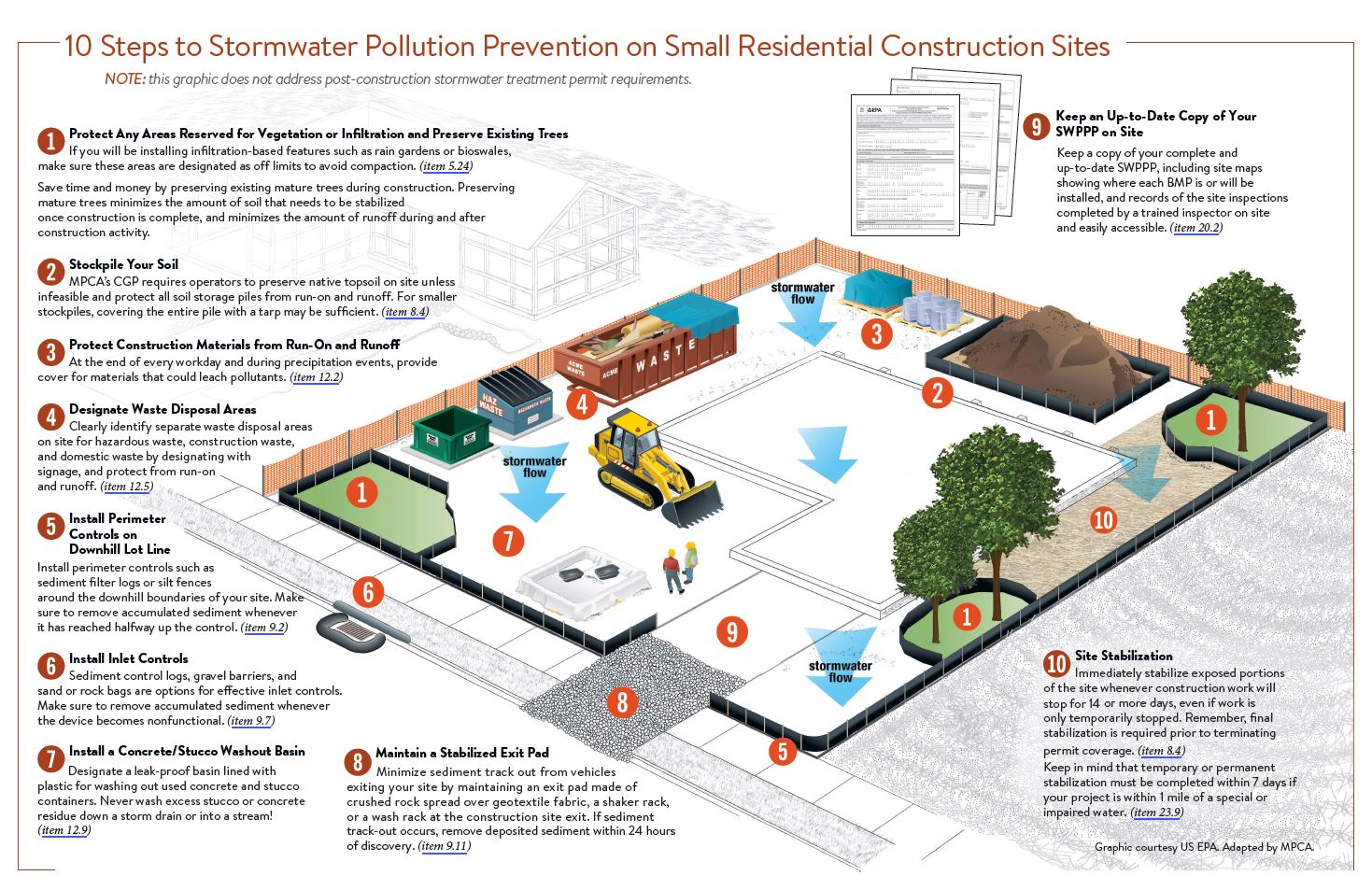
Difference between revisions of "Minnesota Stormwater Manual test page 5"
m |
m |
||
| Line 13: | Line 13: | ||
[[Category:Level 3 - Pollutants/Phosphorus/Phosphorus in runoff]] | [[Category:Level 3 - Pollutants/Phosphorus/Phosphorus in runoff]] | ||
[[Category:Level 3 - Pollutants/Phosphorus/Managing phosphorus]] | [[Category:Level 3 - Pollutants/Phosphorus/Managing phosphorus]] | ||
| + | |||
| + | <imagemap> | ||
| + | Image:Updated MPCA_Small_Site_Graphic.JPG|Image map test | ||
| + | circle 55 152 15 [[Protection of existing trees on construction sites]] | ||
| + | circle 55 291 15 [[Construction stormwater best management practice - stockpile management|Stockpile management]] | ||
| + | circle 55 378 15 [[Construction stormwater best management practice - construction materials management requirements|Construction materials management]] | ||
| + | circle 55 447 15 [[Construction stormwater best management practice - construction materials management requirements|Construction materials management]] | ||
| + | circle 55 564 15 [[Sediment control practices - Perimeter controls for disturbed areas]] | ||
| + | circle 55 714 15 [[Sediment control practices - Storm drain inlet protection]] | ||
| + | circle 55 813 15 [[Construction stormwater best management practice – Concrete, paint, stucco and other washout guidance]] | ||
| + | circle 383 817 15 [[Sediment control practices - Vehicle tracking BMPs]] | ||
| + | circle 388 527 18 [[Protection of existing trees on construction sites]] | ||
| + | circle 395 634 18 [[Sediment control practices - Storm drain inlet protection]] | ||
| + | circle 545 579 18 [[Construction stormwater best management practice – Concrete, paint, stucco and other washout guidance]] | ||
| + | circle 624 433 18 [[Construction stormwater best management practice - construction materials management requirements|Construction materials management]] | ||
| + | circle 667 753 18 [[Sediment control practices - Vehicle tracking BMPs]] | ||
| + | circle 784 677 18 [[Construction stormwater best management practice – Stormwater Pollution Prevention Plan]] | ||
| + | circle 838 805 15 [[Sediment control practices - Perimeter controls for disturbed areas]] | ||
| + | circle 939 358 18 [[Construction stormwater best management practice - construction materials management requirements|Construction materials management]] | ||
| + | circle 1004 421 18 [[Construction stormwater best management practice - stockpile management|Stockpile Management]] | ||
| + | circle 1035 660 15 [[Protection of existing trees on construction sites]] | ||
| + | circle 1110 136 15 [[Construction stormwater best management practice – Stormwater Pollution Prevention Plan]] | ||
| + | circle 1182 557 15 [[Construction stormwater best management practice – Site stabilization]] | ||
| + | circle 1132 711 15 [[Construction stormwater best management practice – Site stabilization]] | ||
| + | circle 1297 450 18 [[Protection of existing trees on construction sites]] | ||
| + | rect 449 170 507 185 [https://stormwater.pca.state.mn.us/index.php?title=MN_CSW_Permit_Section_5_Stormwater_Pollution_Prevention_Plan_(SWPPP)_Content#5.24 The SWPPP must describe methods to minimize soil compaction and preserve topsoil. Minimizing soil compaction is not required where the function of a specific area dictates compaction.] | ||
| + | rect 409 327 459 342 [https://stormwater.pca.state.mn.us/index.php?title=MN_CSW_Permit_Section_8_Erosion_Prevention_Practices#8.4 Permittees must stabilize all exposed soil areas, including stockpiles. Stabilization must be initiated immediately to limit soil erosion when construction activity has ceased on any portion of the site and will not resume for a period exceeding 14 calendar days. Stabilization must be completed no later than 14 calendar days after the construction activity has ceased. Stabilization is not required on certain temporary stockpiles but must provide sediment controls at the base of the stockpile.] | ||
| + | rect 310 397 368 412 [https://stormwater.pca.state.mn.us/index.php?title=MN_CSW_Permit_Section_12_Pollution_Prevention_Management_Measures#12.2 Permittees must place building products and landscape materials under cover (e.g., plastic sheeting or temporary roofs) or protect them by similarly effective means designed to minimize contact with stormwater. Permittees are not required to cover or protect products which are either not a source of contamination to stormwater or are designed to be exposed to stormwater.] | ||
| + | rect 107 514 165 529 [https://stormwater.pca.state.mn.us/index.php?title=MN_CSW_Permit_Section_12_Pollution_Prevention_Management_Measures#12.5 Permittees must properly store, collect and dispose solid waste in compliance with Minn. R. ch. 7035.] | ||
| + | rect 258 665 308 680 [https://stormwater.pca.state.mn.us/index.php?title=MN_CSW_Permit_Section_9_Sediment_Control_Practices#9.2 Permittees must establish sediment control BMPs on all downgradient perimeters of the site and downgradient areas of the site that drain to any surface water, including curb and gutter systems. Permittees must locate sediment control practices upgradient of any buffer zones. Permittees must install sediment control practices before any upgradient land-disturbing activities begin and must keep the sediment control practices in place until they establish permanent cover.] | ||
| + | rect 243 765 293 780 [https://stormwater.pca.state.mn.us/index.php?title=MN_CSW_Permit_Section_9_Sediment_Control_Practices#9.7 Permittees must protect all storm drain inlets using appropriate BMPs during construction until they establish permanent cover on all areas with potential for discharging to the inlet.] | ||
| + | rect 39 882 98 896 [https://stormwater.pca.state.mn.us/index.php?title=MN_CSW_Permit_Section_12_Pollution_Prevention_Management_Measures#12.9 Permittees must provide effective containment for all liquid and solid wastes generated by washout operations related to the construction activity. Permittees must prevent liquid and solid washout wastes from contacting the ground and must design the containment so it does not result in runoff from the washout operations or areas. ermittees must properly dispose liquid and solid wastes in compliance with MPCA rules. Permittees must install a sign indicating the location of the washout facility.] | ||
| + | rect 447 900 506 914 [https://stormwater.pca.state.mn.us/index.php?title=MN_CSW_Permit_Section_9_Sediment_Control_Practices#9.11 Permittees must install a vehicle tracking BMP to minimize the track out of sediment from the construction site or onto paved roads within the site.] | ||
| + | rect 1254 237 1309 252 [https://stormwater.pca.state.mn.us/index.php?title=MN_CSW_Permit_Section_20_SWPPP_Availability Permittees must keep the SWPPP, including all changes to it, and inspections and maintenance records at the site during normal working hours by permittees who have operational control of that portion of the site.] | ||
| + | rect 1218 797 1268 812 [https://stormwater.pca.state.mn.us/index.php?title=MN_CSW_Permit_Section_8_Erosion_Prevention_Practices#8.4 Permittees must stabilize all exposed soil areas, including stockpiles. Stabilization must be initiated immediately to limit soil erosion when construction activity has permanently or temporarily ceased on any portion of the site and will not resume for a period exceeding 14 calendar days. Stabilization must be completed no later than 14 calendar days after the construction activity has ceased. Stabilization is not required on constructed base components of roads, parking lots and similar surfaces.] | ||
| + | rect 1209 863 1268 878 [https://stormwater.pca.state.mn.us/index.php?title=MN_CSW_Permit_Section_23_Discharges_to_Special_(Prohibited,_Restricted,_Other)_and_Impaired_Waters#23.9 Permittees must immediately initiate stabilization of exposed soil areas, as described in item 8.4, and complete the stabilization within seven (7) calendar days after the construction activity in that portion of the site temporarily or permanently ceases.] | ||
| + | </imagemap> | ||
| + | --> | ||
<div class="mw-collapsible mw-collapsed" style="width:100%"> | <div class="mw-collapsible mw-collapsed" style="width:100%"> | ||
Revision as of 21:46, 27 June 2022
Warning: This page is an edit and testing page use by the wiki authors. It is not a content page for the Manual. Information on this page may not be accurate and should not be used as guidance in managing stormwater.
-->
Information
Reporting phosphorus and TSS reduction credits from street sweeping

Research conducted by Bill Selbig (USGS) shows that streets, when cleaned of leaf litter prior to a storm, can significantly decrease phosphorus loads in stormwater runoff (Link to study)
At this time, the MPCA has not developed guidance for how to credit reductions in phosphorus or total suspended solid loading associated with enhanced street sweeping. We anticipate developing this guidance in 2022. In developing this guidance, consider the following.
- Baseline: Credits toward permit compliance, such as compliance with total maximum daily loads, can only be applied toward enhanced street sweeping. This is sweeping that results in pollutant reductions above pollutant reductions associated with sweeping that occurred at the baseline year.
- Accounting for seasonality: The image on the right illustrates the seasonal nature of phosphorus loading in areas where leaves and other organic sources are a source of phosphorus. Most models and other methods of estimating annual loads do not consider this seasonality and most likely significantly underestimates annual phosphorus loading. Accurate representation of impacts from enhanced street sweeping will require adjusting initial (baseline) calculations of loading. The MPCA is discussing appropriate methods for accounting for this seasonality.
- Downstream BMPs: Enhanced street sweeping potentially impacts loading to and performance of downstream BMPs. The MPCA is discussing if adjustments in downstream loading and/or adjustments in BMP performance are needed to accurately determine changes in phosphorus loading in areas where enhanced street sweeping is implemented.
Categories:
- Level 1 - Best Management practices
- Level 1 - Management
- Level 1 - Pollutants
- Level 1 - Regulatory
- Level 2 - Best management practices/Design criteria
- Level 2 - Best management practices/Construction specifications
- Level 2 - Best management practices/Credits
- Level 2 - Pollutants/Phosphorus
- Level 2 - Pollutants/Bacteria
- Level 2 - Pollutants/Total suspended solids
- Level 3 - Pollutants/Phosphorus/Phosphorus in runoff
- Level 3 - Pollutants/Phosphorus/Managing phosphorus
- Test page

